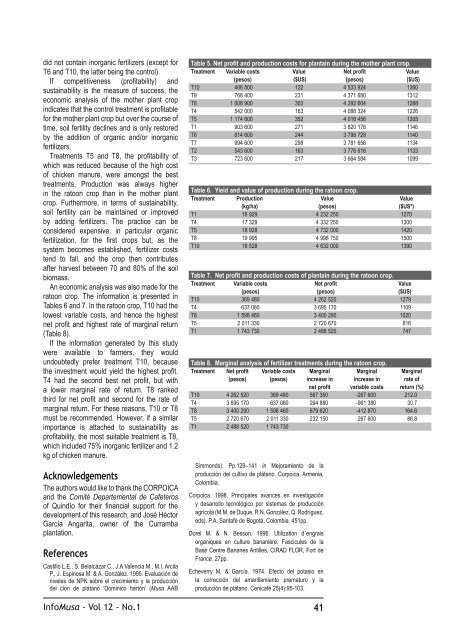Château-Musa - Bioversity International
Château-Musa - Bioversity International
Château-Musa - Bioversity International
You also want an ePaper? Increase the reach of your titles
YUMPU automatically turns print PDFs into web optimized ePapers that Google loves.
did not contain inorganic fertilizers (except for<br />
T6 and T10, the latter being the control).<br />
If competitiveness (profitability) and<br />
sustainability is the measure of success, the<br />
economic analysis of the mother plant crop<br />
indicates that the control treatment is profitable<br />
for the mother plant crop but over the course of<br />
time, soil fertility declines and is only restored<br />
by the addition of organic and/or inorganic<br />
fertilizers.<br />
Treatments T5 and T8, the profitability of<br />
which was reduced because of the high cost<br />
of chicken manure, were amongst the best<br />
treatments. Production was always higher<br />
in the ratoon crop than in the mother plant<br />
crop. Furthermore, in terms of sustainability,<br />
soil fertility can be maintained or improved<br />
by adding fertilizers. The practice can be<br />
considered expensive, in particular organic<br />
fertilization, for the first crops but, as the<br />
system becomes established, fertilizer costs<br />
tend to fall, and the crop then contributes<br />
after harvest between 70 and 80% of the soil<br />
biomass.<br />
An economic analysis was also made for the<br />
ratoon crop. The information is presented in<br />
Tables 6 and 7. In the ratoon crop, T10 had the<br />
lowest variable costs, and hence the highest<br />
net profit and highest rate of marginal return<br />
(Table 8).<br />
If the information generated by this study<br />
were available to farmers, they would<br />
undoubtedly prefer treatment T10, because<br />
the investment would yield the highest profit.<br />
T4 had the second best net profit, but with<br />
a lower marginal rate of return. T8 ranked<br />
third for net profit and second for the rate of<br />
marginal return. For these reasons, T10 or T8<br />
must be recommended. However, if a similar<br />
importance is attached to sustainability as<br />
profitability, the most suitable treatment is T8,<br />
which included 75% inorganic fertilizer and 1.2<br />
kg of chicken manure.<br />
Acknowledgements<br />
The authors would like to thank the CORPOICA<br />
and the Comité Departemental de Cafeteros<br />
of Quindío for their financial support for the<br />
development of this research, and José Héctor<br />
García Angarita, owner of the Curramba<br />
plantation.<br />
References<br />
Castillo L.E., S. Belalcázar C., J.A Valencia M., M.I. Arcila<br />
P., J. Espinosa M. & A. González. 1995. Evaluación de<br />
niveles de NPK sobre el crecimiento y la producción<br />
del clon de plátano ‘Dominico hartón’ (<strong>Musa</strong> AAB<br />
Table 5. Net profit and production costs for plantain during the mother plant crop.<br />
Treatment Variable costs Value Net profit Value<br />
(pesos) ($US) (pesos) ($US)<br />
T10 406 500 122 4 533 924 1360<br />
T9 768 400 231 4 371 680 1312<br />
T8 1 008 900 303 4 292 604 1288<br />
T4 542 000 163 4 088 324 1226<br />
T5 1 174 600 352 4 016 456 1205<br />
T1 903 600 271 3 820 176 1146<br />
T6 814 600 244 3 798 728 1140<br />
T7 994 600 298 3 781 656 1134<br />
T2 543 600 163 3 776 616 1133<br />
T3 723 600 217 3 664 584 1099<br />
Table 6. Yield and value of production during the ratoon crop.<br />
Treatment Production Value Value<br />
(kg/ha) (pesos) ($US*)<br />
T1 16 929 4 232 250 1270<br />
T4 17 329 4 332 250 1300<br />
T5 18 928 4 732 000 1420<br />
T8 19 995 4 998 750 1500<br />
T10 18 528 4 632 000 1390<br />
Table 7. Net profit and production costs of plantain during the ratoon crop.<br />
Treatment Variable costs Net profit Value<br />
(pesos) (pesos) ($US)<br />
T10 369 480 4 262 520 1279<br />
T4 637 080 3 695 170 1109<br />
T8 1 598 460 3 400 290 1020<br />
T5 2 011 330 2 720 670 816<br />
T1 1 743 730 2 488 520 747<br />
Table 8. Marginal analysis of fertilizer treatments during the ratoon crop.<br />
Treatment Net profit Variable costs Marginal Marginal Marginal<br />
(pesos) (pesos) increase in increase in rate of<br />
net profit variable costs return (%)<br />
T10 4 262 520 369 480 567 350 -267 600 212.0<br />
T4 3 695 170 637 080 294 880 -961 380 30.7<br />
T8 3 400 290 1 598 460 679 620 -412 870 164.6<br />
T5 2 720 670 2 011 330 232 150 267 600 86.8<br />
T1 2 488 520 1 743 730<br />
Simmonds). Pp.129–141 in Mejoramiento de la<br />
producción del cultivo de plátano. Corpoica, Armenia,<br />
Colombia.<br />
Corpoica. 1998. Principales avances en investigación<br />
y desarrollo tecnológico por sistemas de producción<br />
agrícola (M.M. de Duque, R.N. González, Q. Rodríguez,<br />
eds). P.A. Santafé de Bogotá, Colombia. 451pp.<br />
Dorel M. & N. Besson. 1996. Utilization d´engrais<br />
organiques en culture bananière. Fascicules de la<br />
Base Centre Bananes Antilles, CIRAD FLOR, Fort de<br />
France. 27pp.<br />
Echeverry M. & García. 1974. Efecto del potasio en<br />
la corrección del amarillamiento prematuro y la<br />
producción de plátano. Cenicafé 25(4):95-103.<br />
Info<strong>Musa</strong> - Vol 12 - No.1 41

















